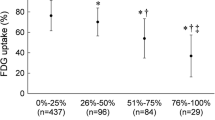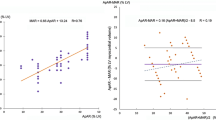Abstract
We tested the possibility of identifying areas of hibernating myocardium by the combined assessment of perfusion and metabolism using single photon emission tomography (SPET) with technetium-99m hexakis 2-methoxyisobutylisonitrile (99mTc-MIBI) and positron emission tomography (PET) with fluorine-18 fluoro-2-deoxy-d-glucose (18F-FDG). Segmental wall motion, perfusion and 18F-FDG uptake were scored in 5 segments in 14 patients with coronary artery disease (CAD), for a total number of 70 segments. Each subject underwent the following studies prior to and following coronary arterybypass grafting (CABG): first-pass radionuclide angiography, electrocardiography gated planar perfusion scintigraphy and SPET perfusion scintigraphy with 99mTc-MIBI and, after 16 h fasting, 18F-FDG/PET metabolic scintigraphy. Wall motion impairment was either decreased or completely reversed by CABG in 95% of the asynergic segments which exhibited 18F-FDG uptake, whereas it was unmodified in 80% of the asynergic segments with no 18-FDG uptake. A stepwise multiple logistic analysis was carried out on the asynergic segments to estimate the postoperative probability of wall motion improvement on the basis of the preoperative regional perfusion and metabolic scores. The segments with the highest probability (96%) of functional recovery from preoperative asynergy after revascularization were those with a marked 18F-FDG uptake prior to CABG. High probabilities of functional recovery were also estimated for the segments presenting with moderate and low 18F-FDG uptake (92% and 79%, respectively). A low probability of functional recovery (13 %) was estimated in the segments with no 18F-FDG uptake. Despite the potential limitations due to the semiquantitative analysis of the images, the method appears to provide reliable information for the diagnostic and prognostic evaluation of patients with CAD undergoing CABG and confirms that the identification of hibernating myocardium with 18F-FDG is of paramount importance in the diagnosis of patients undergoing CABG.
Similar content being viewed by others
References
Baillet GY, Mena IG, Kuperus JH, Robertson JM, French WJ (1989) Simultaneous technetium-99m MIBI angiography and myocardial perfusion imaging. J Nucl Med 30:38–44
Bergmann SR, Fox KAA, Rand AL, McElvany KD, Welch MJ, Markham J, Sobel BE (1984) Quantification of regional myocardial blood flow in vivo with H2 15O. Circulation 70:724–731
Bergmann SR, Herrero P, Markham J, Weinheimer CJ, Walsh MN (1989) Noninvasive quantitation of myocardial blood flow in human subjects with oxygen-I5-labeled water and positron emission tomography. J Am Coll Cardiol 14:639–652
Berry JJ, Baker JA, Pieper KS, Hanson MW, Hoffman JM, Coleman RE (1991) The effect of metabolic milieu on cardiac PET imaging using fluorine-18-deoxyglucose and nitrogen-13-ammonia in normal volunteers. J Nucl Med 32:1518–1525
Bing RJ (1965) Cardiac metabolism. Physiol Rev 45:171–213
Bruce RA, Blackmon JR, Jones JW, Strait G (1963) Exercise testing in adult normal subjects and cardiac patients. Pediatrics 32:742–756
Buckberg GD (1987) Strategies and logic of cardioplegic delivery to prevent, avoid and reverse ischemic and reperfusion damage. J Thorac Cardiovasc Surg 93:127–139
Buckberg GD (1989) Antegrade/retrograde blood cardioplegia to ensure cardioplegic distribution: operative techniques and objectives. J Cardiac Surg 4:216–238
Engelman L (1985) Stepwise logistic regression. In: DixonWJ (ed) BMDP statistical sofware 1985 printing. University of California Press, Berkeley, pp 330–344
Goldstein RA, Mullani NA, Fisher D, Marani S, Gould KL, O'Brien HA (1983) Myocardial perfusion with rubidium-82. II. The effects of metabolic and pharmacologic interventions. J Nucl Med 24:907–915
Gould KL (1991 a) Myocardial viability: what does it mean and how do we measure it? Circulation 83:333–335
Gould KL (1991 b) PET perfusion imaging and nuclear cardiology. J Nucl Med 32:579–606
Gropler RJ, Siegel BA, Lee KJ, Moerlein SM, Perry DJ, Bergmann SR, Geltman EM (1990) Nonuniformity in myocardial accumulation of fluorine-18-fluorodeoxyglucose in normal fasted humans. J Nucl Med 31:1749–1756
Hamacher K, Coenen HH, Stocklin G (1986) Efficient stereospecific synthesis of no-carrier-added 2-[18F]-fluoro-2-deoxy-d-glu-cose using aminopolyether supported nucleophilic substitution. J Nucl Med 27:235–238
Kiat H, Maddahi J, Roy LT, Van Train K, Friedman J, Resser K, Berman DS (1989) Comparison of technetium 99m methoxy isobutyl isonitrile and thallium 201 for evaluation of coronary artery disease by planar and tomographic methods. Am Heart J 117:1–11
Krivokapich J, Huang SC, Phelps ME, Barrio JR, Watanabe CR, Selin CE, Shine KJ (1982) Estimation of rabbit myocardial metabolic rate for glucose using fluorodeoxyglucose. Am J Physiol 243:H884-H895
Maddahi J, Van Train KF, Wong C, Gurewitz J, Prigent F, Youngkin C, Friedman J, Berman D (1986) Comparison of T1–201 single photon emission computerized tomography (SPELT) and planar imaging for evaluation of coronary artery disease (abstract). J Nucl Med 27:999
Marcassa C, Marzullo P, Parodi O, Sambuceti G, L'Abbate A (1990) A new method for noninvasive quantitation of segmental wall thickening using technetium-99m 2-methoxy-isobutyl-isonitrile scintigraphy - results in normal subjects. J Nucl Med 31:173–177
Marshall RC, Tillisch J, Phelps M, Huang SC, Carson R, Henze E, Schelbert H (1983) Identification and differentiation of resting myocardial ischemia and infarction in man with positron computed tomography. Circulation 67:766–778
Mullani NA, Goldstein RA, Gould KL, Fisher DJ, Marani SK, O'Brien HA (1983) Myocardial perfusion with rubidium-82. I. Measurement of extraction fraction and flow with external detectors. J Nucl Med 24:898–906
Phelps ME, Hoffman EJ, Selin CE, Huang SC, Robinson G, MacDonald N, Schelbert H, Kuhl DE (1978) Investigation of [18F]2-fluoro-2-deoxyglucose for the measure of myocardial glucose metabolism. J Nucl Med 19:1311–1319
Schelbert HR, Phelps ME, Hoffman EJ, Huang SC, Selin CE, Kuhl DE (1979) Regional myocardial perfusion assessed with N-13 labeled ammonia and positron emission computerized axial tomography. Am J Cardiol 43:209–213
Schelbert HR, Phelps ME, Huang SC, MacDonald NS, Hansen H, Selin CE, Kuhl DE (1981) N-13 ammonia as an indicator of myocardial blood flow. Circulation 63:1259–1263
Schwaiger M, Hicks R (1991) The clinical role of metabolic imaging of the heart by positron emission tomography. J Nucl Med 32:565–578
Strauss HW, Harrison K, Langal JK, Lebowitz E, Pitt B (1975) Thallium-201 for myocardial imaging. Relation of thallium-201 to regional myocardial perfusion. Circulation 51:641–645
Tamaki N, Yonekura Y, Yamashita K, Saji H, Magata Y, Senda M, Konishi Y, Hirata K, Ban T, Konishi J (1989) Positron emission tomography using fluorine-18 deoxyglucose in evaluation of coronary artery bypass grafting. Am J Cardiol 64:860–865
Tillisch J, Brunken R, Marshall R, Schwaiger M, Mandelkern M, Phelps M, Schelbert H (1986) Reversibility of cardiac wall motion abnormalities predicted by positron tomography. N Engl J Med 314:884–888
Wackers FJT, Berman DS, Maddahi J, Watson DD, Beller GA, Strauss HW, Boucher CA, Picard M, Holman BL, Fridrich R, Inglese E, Delaloye B, Bischof-Delaloye A, Camin L, McKusick K (1989) Technetium-99m hexakis 2-methoxy isobutyl isonitrile: human biodistribution, dosimetry, safety, and preliminary comparison to thallium-201 for myocardial perfusion imaging. J Nucl Med 30:301–311
Villanueva-Meyer J, Mena I, Narahara KA (1990) Simultaneous assessment of left ventricular wall motion and myocardial perfusion with technetium-99m-methoxy isobutyl isonitrile at stress and rest in patients with angina: comparison with thallium-201 SPELT. J Nucl Med 31:457–463
Yamada K, Endo S, Fukuda H, Abe Y, Yoshioka S, Itoh M, Kubota K, Hatazawa J, Satoh T, Matsuzawa T, Ido T, Iwata R, Ishiwata K, Takahashi T (1985) Experimental studies on myocardial glucose metabolism of rats with 18F-2-fluoro-2-deoxy-d-glucose. Eur J Nucl Med 10:341–345
Author information
Authors and Affiliations
Additional information
Correspondence to: G. Lucignani
Rights and permissions
About this article
Cite this article
Lucignani, G., Paolini, G., Landoni, C. et al. Presurgical identification of hibernating myocardium by combined use of technetium-99m hexakis 2-methoxyisobutylisonitrile single photon emission tomography and fluorine-18 fluoro-2-deoxy-d-glucose positron emission tomography in patients with coronary artery disease. Eur J Nucl Med 19, 874–881 (1992). https://doi.org/10.1007/BF00168164
Received:
Revised:
Issue Date:
DOI: https://doi.org/10.1007/BF00168164




